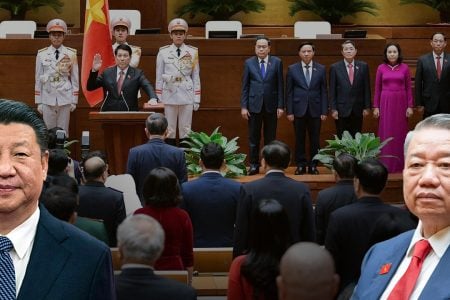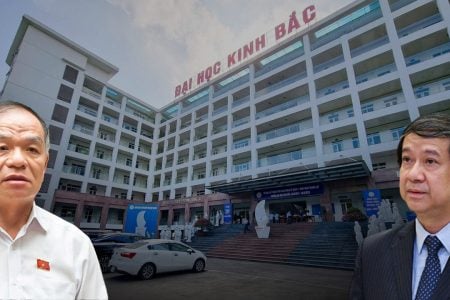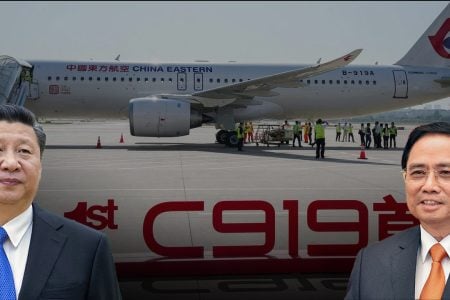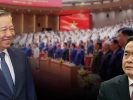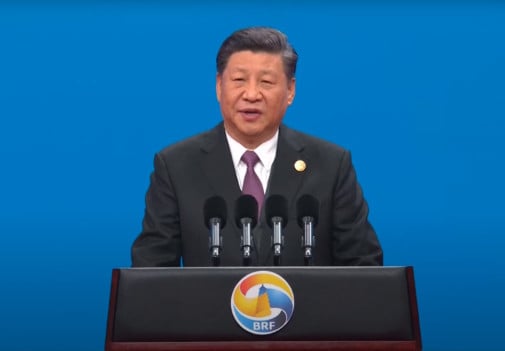
China’s policy on the South China Sea (Vietnamese call it the East Sea) became more aggressive after Xi Jinping became China’s highest leader in November 2012. We can gauge the magnitude of this aggression by considering how, after coming to power, Xi Jinping implemented China’s policy on the South China Sea.
Keep up with unreasonable and excessive claims
Many people believe that Trump is the one who can force China lower its aggressiveness in the South China Sea issue. However, the fact is that during Donald Trump’s presidency, China’s control over entities in the South China Sea remains unchanged. These groups of entities include the entire Hoang Sa (Paracels); a number of rocks of Truong Sa (Spratlys) such as Xu Bi, Ga Ven, Tu Nghia, Gac Ma, Cross, Chau Vien, Vanh towels; and Scarborough Shoal.
China’s sovereignty claims, including those over areas over which China does not control, have not changed. China claims territorial sovereignty over most of the features in the South China Sea, including the group of entities belonging to the Paracels and Spratlys and two other groups of reefs, Pratas and Macclefield Bank. China also makes sovereignty claims over internal waters, territorial waters, and contiguous areas that China considers these groups of entities to create.
Furthermore, China claims to have rights and interests in the South China Sea, including over exclusive economic zones (EEZs) and continental shelf, which China considers this group of entities to enjoy, even if they are not allowed. China also claims historic rights over the South China Sea, namely the „nine-dash line“ area. Rights and interests of this „nine-dashed line“ have a more limited scope than territorial sovereignty – they are primarily concerned with jurisdiction over economic resources in the sea such as fish and oil and gas, including those within the „nine-dash line„.
China’s sovereignty claims reflect the assertiveness of its policy and are used to mobilize domestic support for that policy. In addition, these claims can also act as a lever in territorial dispute resolution negotiations. China has used these levers to settle territorial disputes with Myanmar, Russia, Vietnam and Central Asian countries.
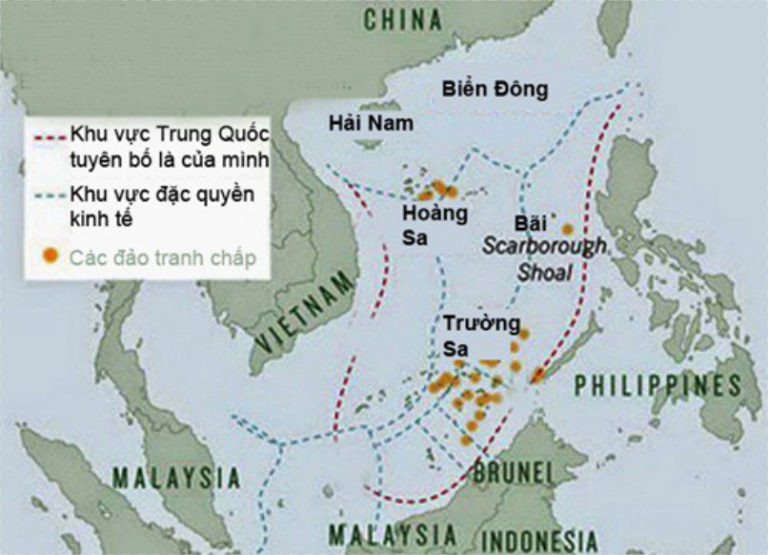
China under Xi Jinping has started a large-scale land reclamation project on the reefs it controls in the Spratly Islands since 2013. This project has turned the coral reefs, which have a stimulating effect. small and barely above water at low tide, forming large man-made islands. The total area of improved land is up to more than 10 square kilometers. For example, Su Bi rock was expanded to 4 square kilometers, Cross rock to 2.83 square kilometers, and Vanh Vai rock to 5.52 square kilometers 2. Meanwhile, the natural size of Ba Binh Island, the largest island of the Spratlys, is only about 0.51 square kilometers. Finally, Phu Lam Island, the largest island of the Paracels, was expanded from 2.13 square kilometers to 3.16 square kilometers.
The large-scale reclamation has given China ample land for the construction of large airports, deep-water harbors, as well as monitoring and communication facilities in the South China Sea. The three airports with 3,000 m long runway and hangars were built on Xu Bi, Cross, and Vanh Khan rocks respectively in the Spratlys. These facilities can accommodate the needs of deploying and operating heavy transport vehicles, aerial surveillance and refueling aircraft, as well as bombers and fighters. The harbors in Cross Stone and Phu Lam Island can accommodate ships of 5,000 tons. The expanded land area also allows the People’s Liberation Army of China (PLA) to deploy a large military force. Only in Su Bi rock is believed to have 3,330 PLA troops.
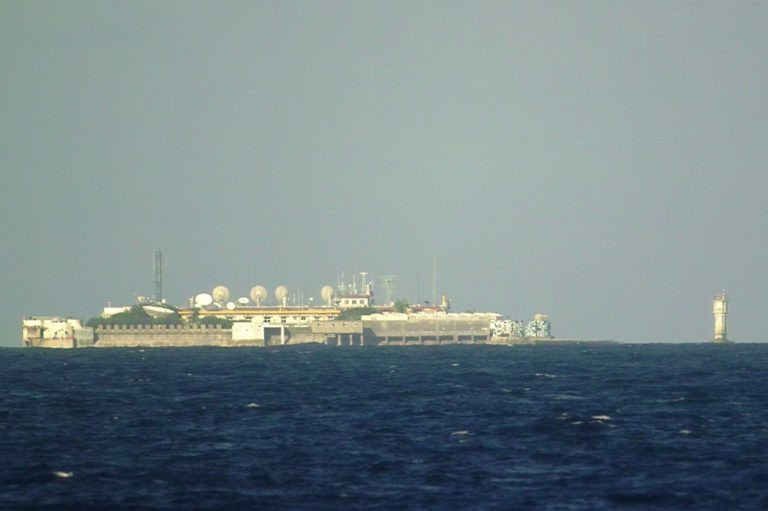
Another bold step in Chinese policy under Xi Jinping was the consolidation of administrative control over the areas China-controlled, as well as its sovereignty, claims to the East Sea. In April 2020, China established two special administrative zones, Tay Sa district, and Nam Sa district, to manage the disputed Paracels, Spratlys, and Macclefield. Meanwhile, China’s Ministry of the Interior and the Ministry of Natural Resources has announced the so-called „standard designation“ for topographic structures in the South China Sea, including 25 shoals and reefs along with 55 mountains and ridges. mountains on the seabed. This is clearly an attempt to unify the jurisdiction of the two special administrative zones by specifying specific jurisdictions.
Two more Chinese policy changes under Xi Jinping could have important implications for its policy on the South China Sea. First, the PLA restructuring after 2015 led to the introduction of the PLA’s Southern War Zone. Under the command of a naval officer, who commands and controls naval, air force, conventional missile and army forces deployed in the area, the Southern War Zone is often interpreted as a strategic school with mainly marine operations. This war zone is believed to protect what China considers territorial and its rights and interests in the South China Sea.
Second is Xi Jinping’s consolidation of China’s maritime law enforcement agencies. Traditionally, these agencies are under five different ministries, including the Marine Supervision Agency (CMS) under the Ministry of Land and Resources, the China Fisheries Law Enforcement Agency (FLEC) under the Ministry of Agriculture, The Coast Guard is the People’s Armed Police (PAP), the Anti-Smuggling Police at China Customs and the Maritime Safety Authority (MSA) of the Ministry of Transport.
The existence of these agencies in many ministries leads to redundancy and waste of resources, as well as policy mistakes due to lack of coordination. In 2013, CMS, FLEC, Coast Guard and Anti-Smuggling Police were merged and placed under the command of the newly established China Coast Guard (CCG). In 2018, CCG became paramilitary.
This restructuring led to the creation of the CCG South Seas Command, commanding six fleets of coast guard ships and one squadron. Since the PAP was to be placed under the PLA’s command and control in 2018, the CCG’s Southern Marine Command will likely be placed under the command and control of the PLA’s Southern War Zone. Consequently, all current coastal protection activities in the South China Sea could be coordinated by the PLA’s Southern War Zone.
What prompted Xi Jinping to increase his level of aggression in the South China Sea?
First, the construction of artificial islands clearly reflects the PLA’s institutional priorities. This helps the PLA take the initiative in reducing damage to Chinese-controlled rocks; strengthening the PLA’s infrastructure, surveillance and logistics capabilities to ensure the security of critical sea lanes and blocking points in the South China Sea; creating bases for strategic nuclear submarines operating in the South China Sea. However, since the PLA had strategic interests in the South China Sea before Xi Jinping took power and the PLA’s plan was not endorsed by Hu Jintao, the change in top leadership positions and differences in Personality can lead to different policy choices.
Hu Jintao is known to be a prudent, advocate of non-intervention and conflict avoidance in handling policy issues. Meanwhile, Xi Jinping is a person who likes to interfere and is not afraid of conflict. As the new leader of China, Xi Jinping is encouraged to consolidate power by favoring the PLA or accepting the PLA’s will, including the building of islands in the South China Sea.
Second, Xi Jinping has zero tolerance in dealing with territorial disputes between China and other countries, probably because of demonstrating his personal power through the issue of sovereignty. This is evident in his frequent warnings that countries should not expect the Chinese people to accept doing things that harm their sovereignty. This contrasts with Jiang Zemin, who has made great concessions in resolving territorial disputes between China and its neighbors.
Third, the availability of critical technologies could be another factor behind the policy changes. The most important contractor in the construction of islands in the South China Sea is China Communication Construction Corporation (CCCG), which develops Chinese infrastructure, including deep-water ports. CCCG owns the Sky Whale, a giant self-propelled suction ship. Based on German technology and put into operation in 2010, Sky Whale plays an important role in the construction of islands in the South China Sea.
In addition, other external factors have also played an important role in accelerating China’s policy changes in the South China Sea. Some people believe that Xi Jinping took advantage of President Obama’s weak South China Sea policy to build artificial islands in the 2013-2015 period. Others argue that China has enlisted the distraction of the US and some Asian governments because of the COVID-19 pandemic to establish two special administrative zones and name the 80 topographic structures in the South China Sea in April 2020.
The logic of this view is that if the US adopts a stiffer policy, China will moderate its behavior. However, after Donald Trump became President, in 2017 the US government declared China its strategic competitor. In July 2020, US Secretary of State Mike Pompeo expressed his support for the 2016 Arbitral Tribunal’s ruling and declared China’s claims in the South China Sea illegal. The US Navy has deployed two aircraft carriers to the South China Sea to conduct a dual carrier campaign. However, rather than moderating its behavior, China has responded by increasing drills and anti-ship ballistic missile launches into the South China Sea.
Most analysts in China have expressed views of the country as a victim of US-led threats aimed at China’s interests in the South China Sea. They believe that these external threats motivate China to make changes in its South China Sea policy. Since the United States and a few Asian countries are exploiting China’s weaknesses to gain an advantage in the South China Sea, China’s policy changes are defensive.
However, some of the military vehicles that China deployed to the South China Sea were for offensive purposes, and China could be thought to be in an offensive position. China may also have shown that its behavior and policy are the source of all tensions. China’s claim for a „nine-dash line“ lacks a legal basis in the international legal system. The overlap between this claim and the EEZ claim of the coastal states is the main cause of tension. In addition, China’s island-building policy has also disrupted the status quo in the South China Sea, causing the region to worry about the risk of military conflict.
Conclude
Through the above analysis and conclusion, we see that, since Xi Jinping became the highest leader of China, he has shown power both at the domestic level and foreign policy, especially in the South China Sea policy. That shows that, in the future, China will not change its position on the South China Sea issue. Therefore, Vietnamese policymakers need to be alert to predict and build a strategy to cope with this attitude of China under Xi Jinping.
Thoibao.de (Translated)
Source: https://www.rfa.org/vietnamese/news/blog/xi-jinping-scs-policy-11292020101836.html













